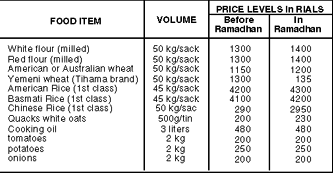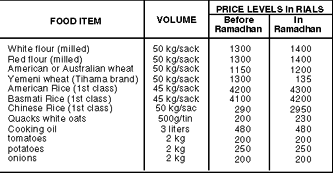
NEW RAMADHAN MENU: Economic Trappings of a Holy Month [Archives:1998/51/Business & Economy]
December 21 1998
By Ghassan Al-Adhal,
Yemen Times.
It is supposed to be a holy month. People are supposed to be more pious; meaning less greedy. But what is happening to the cost of living in Yemen is unbelieveable. Prices during Ramadhan shoot up. Here is the story.
There had been a visible increase in most prices of basic foodstuffs in Ramadhan. As shown by the table below, the rise in prices averaged more than 10% in just a few days until the first day of Ramadhan.
Low-income families usually find such new expenses oproblematic as they compound an already difficult situation. The higher cost of living is complicated by a high unemployment rate. Many young graduates are unable to find jobs at all, et alone in their respective fields.
The rise in price levels in Ramadhan are just the beginning of the new expenses. At the end of this month comes Eid Al-Fitr holidays which bring with them huge expenses. It is traditional for Yemeni families to buy new clothings, eat better food, and indulge in sweets, cakes and other ‘luxuries’ for the average family. I have noted many a bread-winner who is haunted by this upcoming requirements.
Indeed, while Ramadhan brings blessings, it is also a source of financial headaches.
Ramadhan also brings with it a new lifestuyyle, including new dishes and menus. Meals usually differ from traditional ones because of their higher content of fluids and calories.
There are usually two meals in Ramadhan. The iftar meal takes place at sunset, which is around 5:50 pm these days. At this time, people eat dates, shafoot, and porridge, along with sambousa and other delicacies. A large quantity of juices or water is also consumed. This is followed by the Maghrib (sunset) prayer. Most people go back for a full-fledged supper.
After that, it is qat time.
Sahour meal is eaten between 3:00 and 4:00 am in the early hours of the next day. Often, people planning to fast prefer large and filling dishes to sustain them the full day until the next sunset. These are basically ‘aseed, fatta, khobz, and other similar dishes.

The many exhibitions in large cities through which producers and whole-salers directly sell to consumers have helped dampen the inflationary pressures on the price levels. Alas, even that, however, has not stopped the prices from rising.
——
[archive-e:51-v:1998-y:1998-d:1998-12-21-p:./1998/iss51/b&e.htm]


